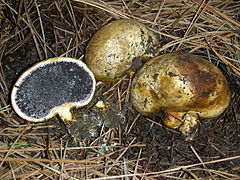Sclerodermatineae
| Sclerodermatineae | |
|---|---|
 |
|
| Scleroderma cepa | |
| Scientific classification | |
| Kingdom: | Fungi |
| Division: | Basidiomycota |
| Class: | Agaricomycetes |
| Subclass: | Agaricomycetidae |
| Order: | Boletales |
| Suborder: |
Sclerodermatineae Manfr.Binder & Bresinsky (2002) |
| Families | |
Sclerodermatineae is a suborder of the fungal order Boletales. Circumscribed in 2002 by mycologists Manfred Binder and Andreas Bresinsky, it contains nine genera and about 80 species. The suborder contains a diverse assemblage fruit body morphologies, including boletes, gasteroid forms, earthstars (genus Astraeus), and puffballs. Most species are ectomycorrhizal, although the ecological role of some species is not known with certainty. The suborder is thought to have originated in the late Cretaceous (145–66 Ma) in Asia and North America, and the major genera diversified around the mid Cenozoic (66–0 Ma).
The Sclerodermatineae was first legitimately used by Manfred Binder and Andreas Bresinsky in 2002 based on molecular analyses of nuclear ribosomal large subunit (25S) rRNA sequences from 60 species of Boletales. This research was an extension of Binder's 1999 graduate work, in which he argued for the need to recognize the molecular differences of the sclerodermatoid fungi. Sclerodermatineae is one of six lineages of the Boletales recognized as a suborder; the others are the Boletineae, Paxillineae, Suillineae, Tapinellineae, and Coniophorineae. Of the nine genera assigned to the Sclerodermatineae, three are hymenomycetes (Boletinellus, Gyroporus, and Phlebopus), and six are gasteroid (Astraeus, Calostoma, Diplocystis, Pisolithus, and Scleroderma). Since the suborder's original description, there have been several phylogenetic studies investigating the Sclerodermatineae. Some studies have revealed the existence of numerous cryptic species and have contributed to taxonomic expansion of the group. The "core" Sclerodermatineae include the genera Astraeus, Calostoma, Scleroderma, Pisolithus, Diplocystis, Tremellogaster (all gasteroid), and the boletoid genus Gyroporus; Phlebopus and Boletinellus resolved as sister to this core group.
...
Wikipedia
